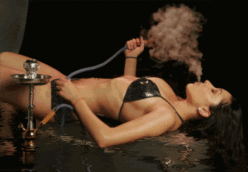LOS ANGELES — Scott Nelson leans back in his chair as he blows smoke rings in the air. The smell of apple and peach tobacco inside the Gypsy Cafe, a hookah bar located just steps away from the University of California at Los Angeles campus, is so thick you can almost taste it as it escapes from the tall water pipes on top of nearly every table.
For hundreds of years, Middle Eastern men have flocked to water pipes — also known as hookahs or nargiles — to smoke fruit-flavored tobacco, talk and watch the world pass by. Now hookah bars are appearing in U.S. cities, including Jacksonville, Fla.; Evanston, Ill.; and Madison, Wis.
In college towns or big cities such as Chicago, San Diego and Washington, these hookah bars aren’t looking to attract older Middle Eastern clientele content to smoke and play chess through the night. Cafe owners want their walls bursting with trend-seeking college students and twentysomethings eager to try the newest thing and tell their friends about it.
“It’s just relaxing,” said Nelson, 19, who drives more than a half-hour every Friday night to hang out at the Gypsy hookah bar.
“We’re addicted to the hookah,” said Catherine Rieder, 18, as she puffed away. “With a cigarette, you can take it with you, but with the hookah, you can only do it once in a while. It’s special.”
Nestled between a movie theater and a cookie store, the Gypsy Cafe, with the feel of an unhurried European coffee shop, attempts to seduce its clients with the taste of another world. Lush purple draperies envelop the richly textured walls, as hookahs — with elegant necks and glass bodies that seem to dance in the light — sit with their hoses wrapped around their necks like exotic snakes, waiting for someone to pluck them from the counter.
Hookah enthusiasts say tobacco smoked from the water pipe contains a small proportion of the nicotine and none of the tar and chemicals found in American cigarettes. Some people even make their way into the dimly lighted lounges to stop smoking cigarettes. But health officials aren’t ready to give the hookah their seal of approval as a healthful way to smoke.
Several studies have indicated that hookah smoke contains significant amounts of nicotine and high amounts of arsenic and other heavy metals, said Tom Houston, director of science and community health advocacy for the American Medical Association. Incidences of lip and tongue cancer among hookah users are reasonably high, and the effect on the heart of using hookahs is the same as that of cigarette smoking, he said.
“They’re only deluding themselves if they think it is a safe way to smoke,” Houston said. Because smoking hookahs is touted as nonaddictive, Houston said he worries about young people who develop a taste for nicotine through smoking a hookah, and “when they can’t find a hookah bar they borrow a cigarette, and there they go.”
The flavored mixture, shisha, is tobacco combined with fruit and molasses or honey. Flavors include mint, jasmine and mango. Double apple — a mixture of red and green apples — remains a bestseller.
To use the hookah, tobacco is placed on a metal plate with a hole in the bottom that connects to a water-filled metal container below and is heated by specialcharcoal . When the smoker inhales, smoke travels through the water, down the tube and into the smoker’s mouth. The result, enthusiasts say, is a delicious assault on the senses that has none of the harshness of cigarette or cigar smoking.
And the experience is easy on the pocketbook. A bowl of tobacco averages $10 and lasts about 45 minutes between two people, leaving plenty of time for conversation and dessert. Many hookah lounges stay open until the wee hours of the morning.
At the Gypsy lounge and its neighbor, the Habibi Cafe, the demand for hookahs is so great that customers often wait more than an hour for a table. The Gypsy experienced a slight dip in business during the early days of the war in Iraq but quickly recovered.
More than 13,000 customers have made their way through the doors of Cafe Hookah in Madison, Wis., since it opened six months ago, owner Vartan Seferian said. With business booming, he plans to open four more Midwest locations in the next few months, all in college towns.
“Having a hookah bar is like going to a mountain with a little hammer and shovel, and finding gold and thinking, how am I going to get all this gold down?” Seferian said. “It has been crazy. Just crazy.”
Seferian is not the only one profiting from the biggest smoking trend since the cigar craze of the mid-1990s. Hookah-related sales grew 500 percent each year over the past three years, even though the earnings of thetobacco industry as a whole has declined slightly.
The Casbah in Jacksonville, Fla., draws a wide range of customers, from men in tuxedoes on their way home from the symphony to college kids looking to try something new, said the owner, Jason Bajalai.
“I guess it’s the fad of the moment,” said Bajalai, the son of Palestinian immigrants.
Cafe owners and enthusiasts attribute the sudden surge in popularity of hookahs to factors including a weak economy and an increased interest in the Middle East.
“We used to see a hookah in the backpack of every tourist, so we decided to bring them here,” Hookah Brothers co-owner Ahmed Roushdy said. The socializing that accompanies a hookah is a big draw, he said. “You might find someone at a bar drinking alone, but you would never find someone sitting alone smoking a hookah.”
© 2003 The Washington Post Company

I see single people smoking at hookah bars all the time